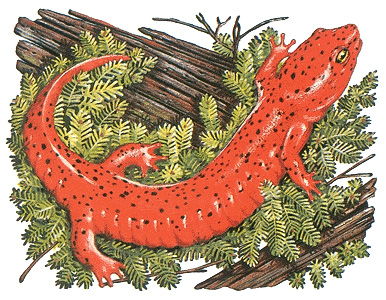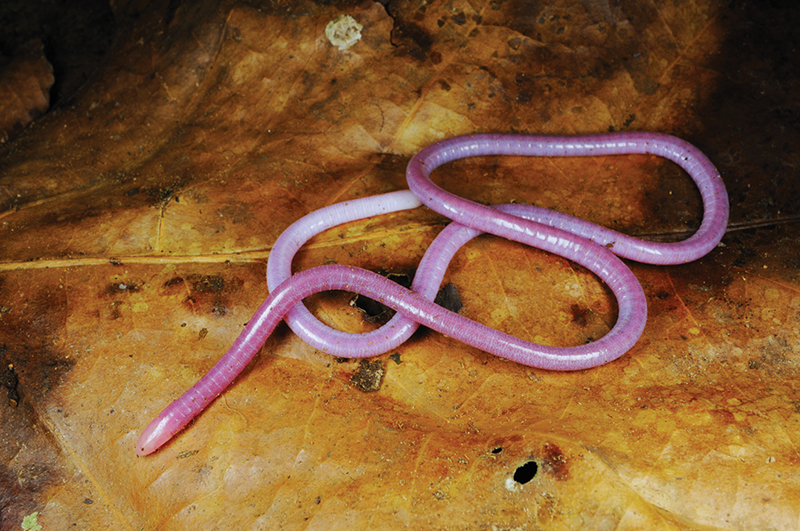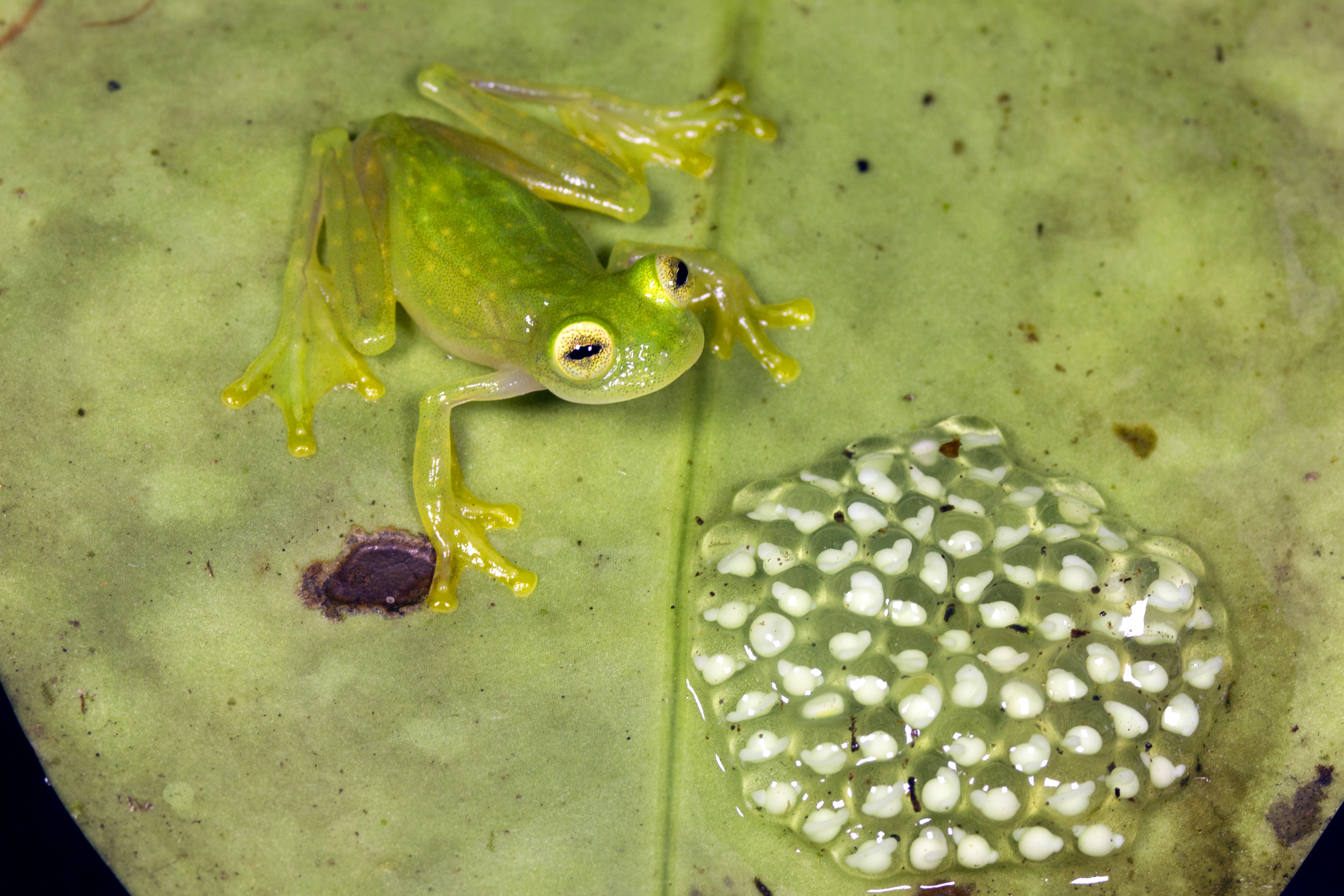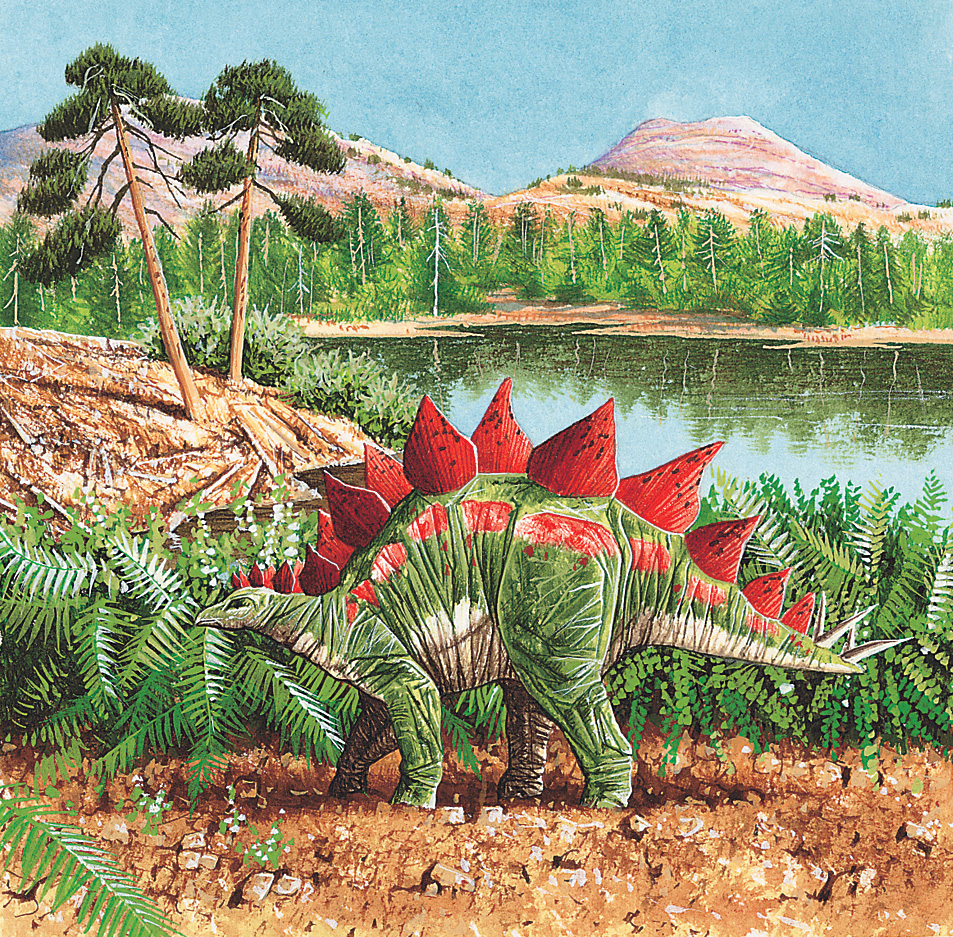Amphibian << am FIHB ee uhn >> is an animal with scaleless skin that usually lives part of its life in water and part on land. There are thousands of kinds of amphibians. They make up one of the classes of vertebrates (animals with backbones) and include frogs, salamanders, and the wormlike caecilians.

Most amphibians hatch from eggs laid in water or moist ground, and they begin life as water-dwelling larvae (young). Through a gradual process called metamorphosis, the larvae change into adults. The adults of most amphibians look much different from larvae. Some adults continue to live in water, but most spend their lives on land. Almost all return to water to find mates and produce young, often returning to the same pond or stream each year.
Loading the player...Frog life cycle
Amphibians generally grow smaller than such other vertebrates as fish, birds, and mammals. Most amphibians measure no more than 6 inches (15 centimeters) long and weigh less than 2 ounces (60 grams). The smallest amphibians are frogs that can sit on a person’s thumbnail. The largest, the Chinese giant salamander, may grow up to about 6 feet (1.8 meters) long.
Amphibians are cold-blooded—that is, their body temperature stays about the same as the temperature of their surroundings. Those that live in regions with harsh winters hibernate during the cold weather. Some amphibians, including the gray tree frog of North America, have evolved substances similar to antifreeze in their blood and tissues. These substances enable the animals to freeze solid and then thaw without suffering harm. Many amphibians that live in warm, dry climates estivate (become inactive during summer). Several kinds, including the Australian water-holding frog, produce a cocoon and may remain in estivation for months at a time.
Amphibians live on every continent except Antarctica. They generally live in moist habitats near ponds, lakes, or streams. Certain tropical tree frogs never leave the trees. They lay their eggs in rainwater that collects at the base of leaves. Some amphibians live in dry regions. They survive for weeks or months in moist places underground, waiting for rain to create puddles. After a rainfall, they gather at the puddles to mate and lay eggs. The eggs hatch and the larvae develop quickly, before the puddles dry up.
Most amphibians eat insects. In some regions, amphibians are quite numerous, and they help maintain the balance of nature. Amphibians aid people by eating insects and insect larvae that destroy crops and carry disease. In some places, people use amphibians as food.
Kinds of amphibians
Zoologists divide amphibians into three groups: (1) frogs, (2) salamanders, and (3) caecilians.
Frogs
have four legs and no tail. They use their long hind legs to jump. There are thousands of species (kinds) of frogs, some of which are commonly called toads. Most frogs live in tropical climates. But some species occur as far north as the Arctic Circle, and others inhabit the southern tip of South America.

Salamanders
have long tails and four—or in a few species, two—short, weak legs. There are hundreds of species of salamanders. Most live in temperate zones—that is, areas between the polar regions and the tropics. Salamanders are also common in warm, humid regions of Central America and South America.

Caecilians
have no legs and look like large earthworms. Most inhabit underground burrows next to streams and ponds, but a few live in water. Caecilians use sensitive tentacles on each side of the head to guide them in their environments. All caecilian species live only in the tropics.
The bodies of amphibians
Skin.
Amphibians have no external scales, hair, or feathers. Most possess smooth skin, but some toads have thick, leathery skin. Their outer layer of skin, called the epidermis, protects their deeper tissues. Adult amphibians shed the outermost portion of the epidermis several times a year. The inner layer of skin, called the dermis, contains many nerves and blood vessels. It also has many glands, which open onto the skin surface. Many amphibians produce mucus, a thick, slimy substance that moistens and protects the skin. Other glands produce poisons that can hurt or kill a predator.
Most amphibians have color patterns that make them difficult to see against their normal background. Some frogs and salamanders have poisonous skin with bright colors to warn predators. Skin color results from pigments (coloring matter) found in special cells that lie just below the epidermis. Movement of the pigments in the cells enables some species to change color rapidly. For example, some change color when the temperature goes up or down, or when the animal is under stress.
Breathing.
Most land-dwelling adult amphibians breathe with lungs. Water-dwelling adults and larvae breathe by means of gills, as do fish. Some aquatic adults have both lungs and gills. In addition, all amphibians take in oxygen through the skin and through the lining of the mouth and throat. More than half of the world’s salamanders belong to a group that has no lungs and breathes only through the skin and mouth.
Digestive system.
Amphibians eat and digest food with the mouth, esophagus (tube to the stomach), stomach, and intestines. Food is mixed and partially digested in the stomach, but most digestion takes place in the small intestine. The stomach walls contain glands that secrete digestive juices, which break food down into substances that can be absorbed and used by the animal’s body. Two large glands—the liver and pancreas—pour digestive juices into the small intestine. Digested food is absorbed from the small intestine, and the remaining wastes travel down the large intestine to the cloaca, a chamber that opens to the outside of the body. Waste products exit the body through the cloaca.
Sense organs.
Most frogs and salamanders have good eyesight, which helps them catch insects. Caecilians’ eyes are either extremely small or completely absent. Most caecilians have little use for eyes in their underground burrows. Water-dwelling amphibians also have a lateral line system, a set of sensitive organs along the sides of the body. It enables an animal to sense movement in the surrounding water.

Frogs can hear a wider range of sounds than can salamanders and caecilians. Frogs have well-developed voices. They use their calls in mating. Caecilians and most salamanders have no voices, and their external ears have been lost. To locate and identify mates, they rely primarily on their sense of smell and taste. In addition to the specialized cells in their nasal passage, amphibians also smell and taste by means of the Jacobson’s organ, a pair of tiny cavities in the roof of the mouth. The tissues that line these cavities respond to chemical changes in the mouth or nose.
Ways of life
Reproduction.
Amphibians generally mate during a rainy period. They gather at night into large groups to find partners. In most frogs, fertilization—that is, the joining of egg and sperm—takes place outside the female’s body. Among most salamanders and all caecilians, fertilization occurs inside the female’s body, before the eggs are laid. In most amphibians, the females lay many eggs at one time. The eggs generally develop and hatch in water or another moist place.
Amphibian eggs have a jellylike covering. The adults usually leave eggs unguarded. But some frogs carry the eggs until they hatch, and many salamanders and caecilians wrap their bodies around the eggs and guard them throughout development. In most species, eggs hatch into larvae with gills, a flattened tail, and tiny limbs or no limbs. Frog larvae are known as tadpoles or polliwogs. Metamorphosis into an adult takes from two weeks to as long as three years, depending on the species. During metamorphosis, larvae slowly lose their gills and develop lungs. Among tadpoles, the hind legs develop before the front legs do. The eyes, digestive system, and other organs must also undergo changes to prepare the animal for life on land.


Food and predators.
Most frog tadpoles eat algae and plants, but salamander larvae feed on tiny aquatic animals. Adult amphibians prey on insects and other small animals. Bullfrogs and other large amphibians may eat snakes, small mammals, and birds. One group of South American frogs feeds mainly on other frogs. Most amphibians use their tongue to capture prey. Some salamanders can shoot out their tongue a distance of more than half their body length to catch food.
Adult amphibians have many predators, including snakes, birds, and mammals. Numerous birds, snakes, fish, and small aquatic animals prey on amphibian larvae. Amphibians use many methods to protect themselves. Some have coloring that enables them to blend into their surroundings. Tree frogs are often green, and ground-dwelling salamanders may be dull gray or brown. Salamanders and caecilians avoid enemies simply by staying out of sight. Caecilians are so well hidden in their burrows that even scientists know little about them. Poisons from the skin glands of some frogs and salamanders irritate the mouths of attackers.
The history of amphibians
The first tetrapods (four-legged animals) to emerge from water and live on land were somewhat like amphibians. These early tetrapods resembled modern amphibians in some respects, especially in their need to return to the water to lay their eggs. In other respects, they somewhat resembled crocodiles. Fossils of these early tetrapods date from the end of the Devonian Period—about 370 million years ago. Scientists believe that tetrapodsevolved (changed over many generations) from lobe-finned fish. Lobe-finned fish had lungs and enlarged fins supported by a bony skeleton. They could use their fins as legs to come out of water for brief periods. These fins evolved into legs with digits (fingers or toes). A variety of early tetrapods with an amphibian way of life flourished in the Carboniferous Period—from about 360 million to 300 million years ago.
Most early tetrapods left no descendants. But some early tetrapods gave rise to the ancestors of modern amphibians and amniotes. Amniotes did not depend so much on water because they produced eggs with shells that would not dry out on land. Amniotes had appeared by about 320 million years ago. Early amniotes were the ancestors of reptiles and mammals. Amniotes became the most important large land animals during the Permian Period, from about 300 million to 250 million years ago. The world’s climate became drier during this time, which put tetrapods with an amphibian way of life at a disadvantage. The groups to which modern amphibians belong did not appear until the Mesozoic Era—from about 250 million to 65 million years ago. By then, most other animals with an amphibian way of life had died out.

Amphibians and people
People have long hunted frogs as a source of food. In addition, some South American cultures have used a secretion from the skin of poisonous frogs to coat the tips of hunting darts. This poisonous secretion attacks the nervous system. Scientists have found medical uses for the chemicals contained in frog skin. These uses include relieving pain in animals and acting as antibiotics against harmful bacteria.
Since the mid-1900’s, amphibian populations have been declining. The causes of these declines have proved complex, and scientists do not fully understand them. In many regions of the world, including parts of Australia, Central America, and the United States, a disease-causing fungus has killed large numbers of frogs. But most of the declines have resulted from human activities, including habitat destruction and pollution. Human beings have polluted rivers and streams with harmful pesticides, weed killers, and such dangerous metals as lead and mercury. People also have released chemicals that create acid rain—that is, precipitation polluted by such acids as sulfuric acid and nitric acid. Exposure to acid rain causes reproductive problems in many amphibians.
